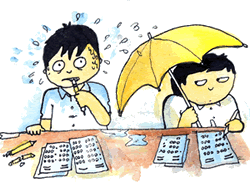The Meaning of Assessment
Pre-assessment are administered before students begin a lesson, unit, course, or academic program. Students are not necessarily expected to know most, or even any, of the material evaluated by pre-assessments—they are generally used to,
(1) establish a baseline against which educators measure learning progress over the duration of a program, course, or instructional period.
(2) To determine general academic readiness for a course, program, grade level, or new academic program that student may be transferring into.
Pre-assessment provides a way for teachers to gather key information
about what students know and are able to do prior to instruction, as well as what
student interests and learning styles are.
Pre-assessments can be paper and pencil
tasks or performance-based.
They provide evidence to help teachers effectively
match instruction with the needs of students. This includes decisions about content,
pacing, materials, grouping, and specific learning activities.
Examples for Pre-assessment :

- End-of-chapter/unit test
- Sequential Roundtable Alphabet (Buehl, D. 2001, p. 33)
- Know-Want-Learn Chart (KWL)
- Performance task such as solving math problems
- Yes/No cards (Gregory & Chapman, 2002, p. 41)
- Anticipation Guide
- Mind Map
- Five-Hardest Most Difficult First (Winebrenner, 2001, pp. 35-39)
The Purpose of the Pre-Assessment and the Way it is Conducted
Pre-assessment plays a critical role in your ability to differentiate instruction. You administer pre-assessments before you being the instruction in a curricular unit in order to gain an understanding of what your students know, understand, and are able to do.
- Differentiate Instruction
- Guide whole-group instruction
- Plan learning activities that address varying levels of readiness
- Determine which students have/have not achieved mastery of specific objectives
- Identify problems that might cause students difficulty with mastery of an objective
- Form flexible groups
- Determine master level of individuals or small groups.
My personal's view/ reflection/ opinion about the issues raised by the assessment
Pre-assessment is a small test to test student what they has learnt after the class. In my opinion, pre-assessment is a very good test for student, due to by it the teacher can know how works the lesson after the class.
For one type of the pre-assessment like mind-map. It is a way to let the student to remember and to more easy to remember what they has learnt after the class. This is due to the fact, mind map is very simple, clearly and concise for student to study or refer back what they had learnt.
Besides that, instructional decisions are based on evidence. Student are challenged at an appropriate level based on prior knowledge and skills. As a result, students are more likely to demonstrate continuous progress and growth.
Lat but not least, by using pre-assessment, student can engaged more by using their interests, learning styles and prior experience.
The Suggestion and Ways to Improve Pre-Assessment
In my opinion, the ways I think can properly run smooth pre-assessment among the students is by making the pre-assessment be more fun, creativity, and relaxed. This is the way that student won't feel any pressure and very excited to involve themselves to take participant nicely in the assessment activity.

For an example, pre-assessment can go through by gaming. Children love game all the time, so most of the student will integrate well in the activity. By this way, not only the children can learn and more remember what they had learnt (recall the memories). For the teacher too, teacher can easily to evaluate the student and also determine how much effectiveness is the lesson.





























